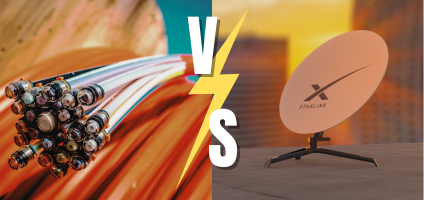
In an era where connectivity is not just a luxury but a necessity, the debate over the most effective means of achieving widespread, high-speed internet access rages on. Recently, the spotlight has fallen on SpaceX’s Starlink project, touted as a revolutionary solution to bring internet connectivity to even the most remote corners of the globe. However, amid the excitement surrounding satellite internet, a crucial question arises: Is it truly the long-term solution we’ve been seeking?
A recent article on MSN highlights some of the challenges facing SpaceX’s Starlink project, shedding light on potential obstacles that may hinder its effectiveness as a global connectivity solution. From concerns about satellite collisions to regulatory hurdles and the sheer cost of maintaining a vast constellation of satellites, the road ahead for Starlink appears fraught with challenges.
But beyond the immediate hurdles facing satellite internet, there’s a larger, more fundamental question at play: What is the most sustainable, reliable, and efficient means of delivering high-speed internet to every corner of the planet? The answer, many argue, lies in terrestrial fiber-optic networks.
An article on Live Science underscores the incredible potential of fiber-optic data transfer, showcasing recent advancements that have pushed the boundaries of data transmission speeds to unprecedented levels. With speeds reaching a mind-boggling 301 terabits per second, fiber-optic technology offers a level of performance that is simply unmatched by any other existing technology.
So, why is terrestrial fiber-optic infrastructure the superior long-term solution for global connectivity? Here are a few key reasons:
Unlike satellite internet, which can be susceptible to interference from atmospheric conditions and space debris, terrestrial fiber-optic networks are inherently more reliable. They are not subject to the same environmental factors that can disrupt satellite signals, making them a more dependable option for delivering consistent, high-speed internet access.
As the demand for data continues to skyrocket, scalability becomes a critical factor in ensuring that our connectivity infrastructure can keep pace with the growing needs of society. Terrestrial fiber-optic networks offer virtually unlimited scalability, with the potential to support exponentially increasing data traffic without compromising performance.
In certain applications, such as online gaming, video conferencing, and real-time financial transactions, low latency is essential for ensuring a seamless user experience. Terrestrial fiber-optic networks offer significantly lower latency compared to satellite internet, making them better suited for latency-sensitive applications.
While the upfront costs of deploying terrestrial fiber-optic infrastructure may be significant, the long-term operational costs are often lower compared to satellite-based solutions. Once the infrastructure is in place, the ongoing maintenance costs are relatively minimal, making fiber-optic networks a more cost-effective option in the long run.
Finally, it’s worth considering the environmental implications of different connectivity solutions. While satellite internet may seem like a more environmentally friendly option at first glance, the reality is that launching and maintaining a constellation of satellites comes with its own set of environmental costs. In contrast, terrestrial fiber-optic networks have a much lower environmental footprint once they are operational.
In conclusion, while projects like SpaceX’s Starlink may offer short-term solutions for bringing internet connectivity to underserved areas, the long-term future of global connectivity lies in the expansion and optimization of terrestrial fiber-optic networks. With their unmatched reliability, scalability, low latency, cost-effectiveness, and minimal environmental impact, fiber-optic infrastructure represents the most promising path forward in our quest to connect the world.
ETI has been providing fiber solutions to telcos, munis and utilities for 30+ years.